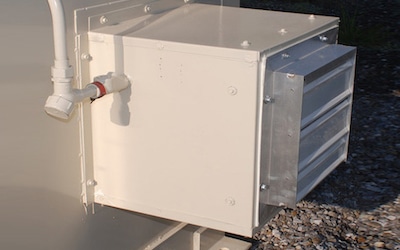The general purpose of
ventilation for a chemical storage building is to create and maintain a safe working environment where chemicals are stored, handled, and mixed. Ventilation is created through the circulation of air by passive or mechanical means. Chemical building ventilation can provide a safe and protected work environment for all industries.
Chemical Building Ventilation to Meet Requirements
Chemical building
ventilation is important to keep personnel and stored chemicals safe from a buildup of vapors that can happen in both storage and open dispensing applications. The ventilation required for flammable storage buildings is described in International Fire Code (sections of Chapters 50 and 57), as well as
NFPA 30 (Chapters 9,10 and 12).
U.S. Chemical Storage provides explosion proof, non-explosion proof and corrosion resistant
exhaust fans for full control of the inventory that you are storing. Store all hazardous material classes compliantly with our mechanical ventilation systems.
Our explosion proof mechanical ventilation system is designed specifically for storing chemicals that produce flammable, explosive and toxic fumes that could be detrimental to human health. Control mechanical ventilation fans by a switch or thermostat. These can also be wired to run continuously, keeping buildings 100% compliant and secure.
Standard mechanical ventilation fans provide an exhaust rate of 6 air changes per hour at a rate no less than 1 cubic foot/minute.
Be sure to implement the proper ventilation system for the correct volume of chemicals being stored. Mechanical ventilation helps create a safe working atmosphere by ensuring the following maintaining a sufficient oxygen level within the storage area.
RELATED ARTICLE: How to Safely Store Chemicals Used in Making Hand Sanitizer
Why is Ventilation Necessary?
In homes, ventilation systems are designed to remove hot air from ceilings and attics. However, chemical storage building ventilation systems are the opposite – think of them as upside down from the systems in homes.
Hazardous fumes are created by spills of flammable or combustible liquids which, if left unattended, will begin to evaporate due to the large surface area of the building. Eventually, the fumes will rise and mix with the air. Depending on the type of chemical spill, this reaction could cause a flame or spark to ignite and, in a worst-case scenario, could cause a catastrophic explosion.
Proper ventilation is imperative to ensure employees and stored chemicals are not harmed. Vents will allow any potentially hazardous fumes to safely exit the building before an explosion can occur. Fumes should be removed as close to the source as possible.
RELATED ARTICLE: Understanding Safe Paint Storage Requirements
Types of Chemical Building Ventilation Systems
In order to select the best ventilation system for your facility, it’s beneficial to understand how each works.
The least complicated system is gravity ventilation. Composed of a single opening in the lower wall of a building, the top of the rising fumes is pulled out of the opening using gravity rather than mechanical assistance. Think of this in terms of a small hole near the bottom of a Starbucks cup. The hole causes coffee to begin to drip, much like the fumes beginning to escape in the case of a gravity system. Fumes are contained near the ground where they will eventually dissipate into the atmosphere.
Natural ventilation also starts with a single low-level vent, but another vent is placed higher up on the opposite wall near the ceiling to allow fumes to be released in elevated areas.
Mechanical ventilation is the most effective method of getting rid of hazardous fumes. Two low-level vents are placed on opposite walls, one for input and one for output. A vertical slack or duct is installed outside the second vent. The fan that is included as part of the system must run continuously and should not be recirculated back into the room, per the
International Fire Code 2704.3.
Order Your Chemical Storage Building with Mechanical Ventilation
Chemical storage and dispensing buildings should have proper ventilation to ensure a safe environment. U.S. Chemical Storage provides chemical building ventilation systems for all your chemical storage needs. Our mechanical ventilation systems provide you with a safe solution for keeping personnel safe while storing hazardous materials. Contact us today for a
free quote.

